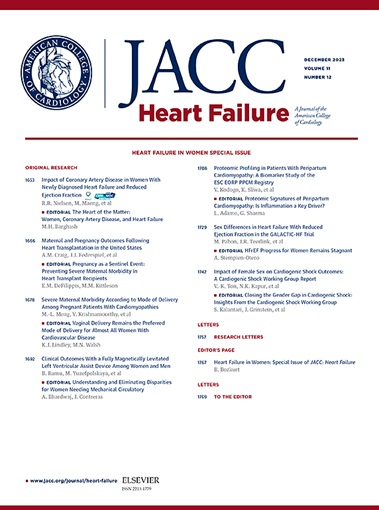心肌梗死患者的矿皮质激素受体拮抗剂
IF 10.3
1区 医学
Q1 CARDIAC & CARDIOVASCULAR SYSTEMS
引用次数: 0
摘要
目前尚不清楚常规使用矿皮质激素拮抗剂(MRA)是否对所有心肌梗死(MI)后患者有益。本研究旨在对随机对照试验进行系统回顾和研究水平的荟萃分析,比较心肌梗死后患者的MRA和非MRA。方法以意向治疗人群为研究对象,采用Peto优势比(or)固定效应模型。主要结局是死亡和新发或恶化的心力衰竭(HF)。结果比较了心肌梗死后HF试验与心肌梗死后非HF试验。结果纳入6项even试验,共18,111名mi后受试者(9064名MRA, 9047名无MRA);一项试验(n = 6642)招募了HF患者。随机接受MRA治疗的患者与未接受MRA治疗的患者相比,死亡风险较低(OR: 0.85 [95% CI: 0.76-0.95];I2 = 0%)和新发或恶化的HF (or: 0.83 [95% CI: 0.73-0.94];I2 = 26.8%)。在心肌梗死后HF试验中,MRA参与者的死亡率获益与数字上的风险差异(RD)较大(478/3,319 vs 554/3,313;Or: 0.84 [95% ci: 0.73-0.96];RD: -2.3% [95% CI: -3.9%至-0.6%]),高于心肌梗死后非hf试验(219/5,745 vs 249/5,734;Or: 0.87 [95% ci: 0.72-1.05];RD -0.5% [95% CI: -1.2%至0.2%];相互作用P = 0.73)。在心肌梗死后HF试验中,MRA分配减少了新发或恶化的HF (345/ 3319 vs 391/ 3313;Or: 0.87 [95% ci: 0.74-1.01];RD: -1.4% [95% CI: -2.8%至0.1%]),与心肌梗死后非心衰试验(126/ 5251 vs 167/ 5241;Or: 0.75 [95% ci: 0.58-0.94];RD: -0.8% [95% CI: -1.3%至-0.2%];相互作用P = 0.29)。结论:在心肌梗死后患者中,MRAs降低了全因死亡率和新发或恶化HF的风险,无论HF状态如何。与心肌梗死后HF试验相比,心肌梗死后非HF试验中观察到的绝对风险降低数值较小。本文章由计算机程序翻译,如有差异,请以英文原文为准。
Mineralocorticoid Receptor Antagonists in Myocardial Infarction Patients
Background
It is unclear whether routine mineralocorticoid antagonist (MRA) use benefits all post–myocardial infarction (MI) patients.
Objectives
This study aims to perform a systematic review and study-level meta-analysis of randomized controlled trials comparing MRA vs no MRA in post-MI participants.
Methods
Using the intention-to-treat population, we used a fixed effect model with Peto odds ratios (ORs). Key outcomes were death and new or worsening heart failure (HF). Results were presented comparing the post-MI HF trial vs post-MI non-HF trials.
Results
Eleven trials, including 18,111 post-MI participants (9,064 MRA, 9,047 no MRA), were included; one trial (n = 6,642) recruited HF patients. Participants randomized to MRA compared to no MRA had a lower risk of death (OR: 0.85 [95% CI: 0.76-0.95]; I2 = 0%) and new or worsening HF (OR: 0.83 [95% CI: 0.73-0.94]; I2 = 26.8%). In the post-MI HF trial, MRA participants experienced a mortality benefit with a numerically larger risk difference (RD) (478/3,319 vs 554/3,313; OR: 0.84 [95% CI: 0.73-0.96]; RD: –2.3% [95% CI: –3.9% to –0.6%]) than in post-MI non-HF trials (219/5,745 vs 249/5,734; OR: 0.87 [95% CI: 0.72-1.05]; RD –0.5% [95% CI: –1.2% to 0.2%]; interaction P = 0.73). In the post-MI HF trial, MRA allocation decreased new or worsening HF (345/3,319 vs 391/3,313; OR: 0.87 [95% CI: 0.74-1.01]; RD: –1.4% [95% CI: –2.8% to 0.1%]) like in the post-MI non-HF trials (126/5,251 vs 167/5,241; OR: 0.75 [95% CI: 0.58-0.94]; RD: –0.8% [95% CI: –1.3% to –0.2%]; interaction P = 0.29).
Conclusions
In post-MI patients, MRAs decrease the risk of all-cause mortality and new or worsening HF regardless of HF status. Numerically smaller absolute risk reductions were observed in the post-MI non-HF trials compared to the post-MI HF trial.
求助全文
通过发布文献求助,成功后即可免费获取论文全文。
去求助
来源期刊

JACC. Heart failure
CARDIAC & CARDIOVASCULAR SYSTEMS-
CiteScore
21.20
自引率
2.30%
发文量
164
期刊介绍:
JACC: Heart Failure publishes crucial findings on the pathophysiology, diagnosis, treatment, and care of heart failure patients. The goal is to enhance understanding through timely scientific communication on disease, clinical trials, outcomes, and therapeutic advances. The Journal fosters interdisciplinary connections with neuroscience, pulmonary medicine, nephrology, electrophysiology, and surgery related to heart failure. It also covers articles on pharmacogenetics, biomarkers, and metabolomics.
 求助内容:
求助内容: 应助结果提醒方式:
应助结果提醒方式:


